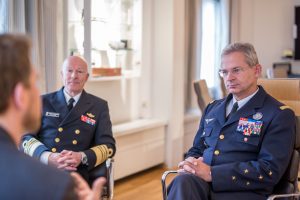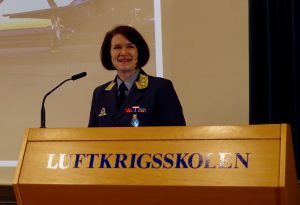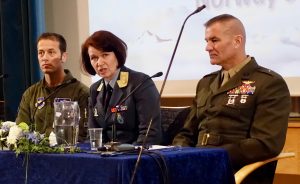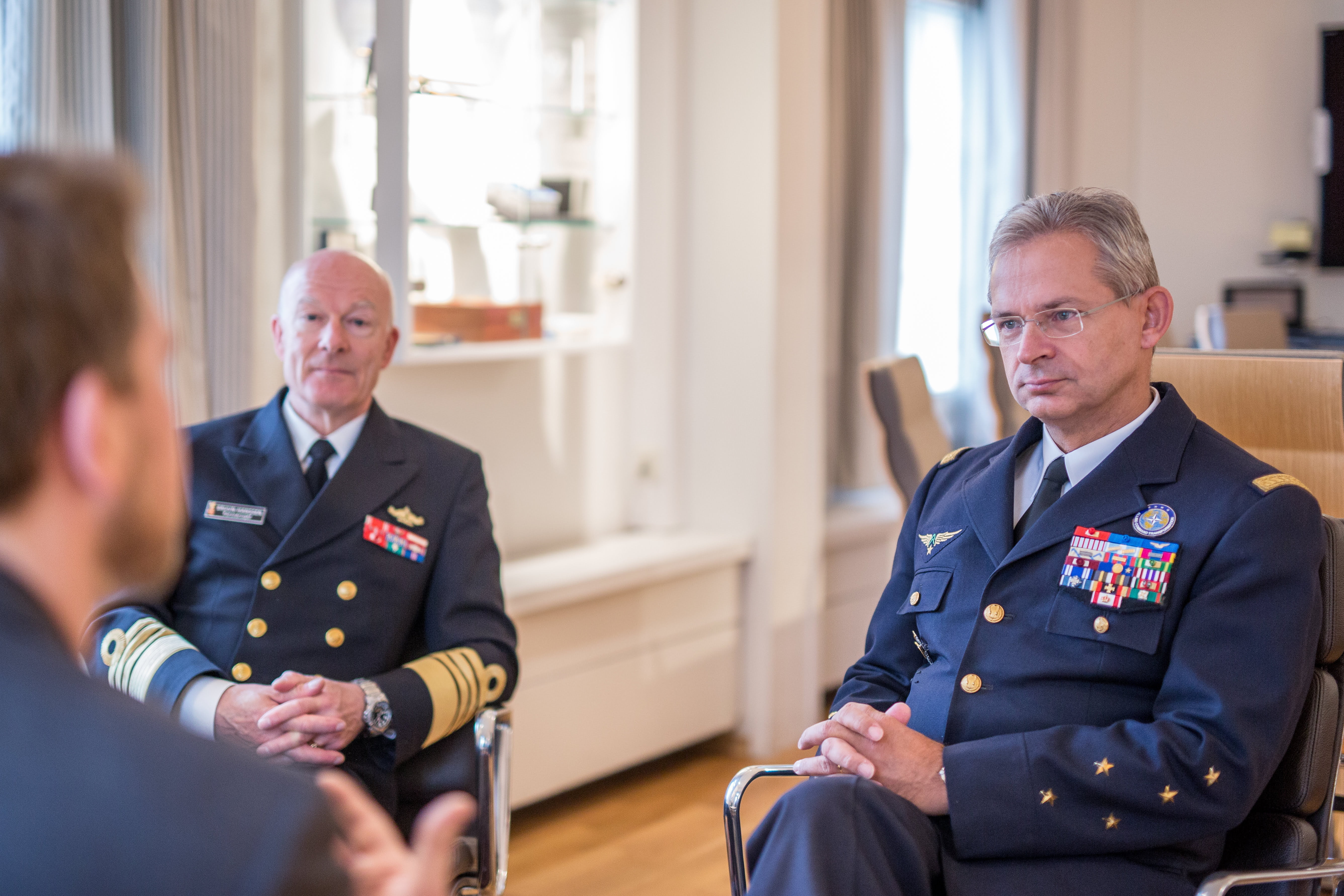2017-06-17 According to an article published on the Norwegian Ministry of Defence website, NATO will be focusing on its core mission of collective defense in the upcoming Trident Juncture exercise.
“NATO needs to hold exercises on a large scale. Only this way are we able to test all the levels in the alliance: From the troops on the ground and all the way up to a strategic level”, says General Denis Mercier, Supreme Allied Commander Transformation (SACT) in NATO.
 General Mercier (right) together with Norway’s Chief of Defence, Admiral Haakon Bruun-Hanssen.
General Mercier (right) together with Norway’s Chief of Defence, Admiral Haakon Bruun-Hanssen.
The French General thinks Norway will be ideal for an exercise on this scale.
“NATO needs realistic training, where we can combine operations in the air, at sea and on land. In Norway we get everything, this is one of the best places to train in Europe”, says Mercier.
“The cold climate also brings extra challenges for the soldiers, that hones their skill.”
RENEWED FOCUS
For many years, NATO has been occupied with international conflicts, but recent developments have led to a renewed focus on the core of the alliance.
“Collective defence and training for this will be key. This is one of NATO’s core missions and we will spend more time on this in the future”, says general Denis Mercier.
The General underlines the importance in focusing on the core mission: NATO as a defensive organisation.
“Deterrence is key for NATO. With large-scale exercises we can demonstrate our capacity and uphold our credibility.”
https://forsvaret.no/en/taking-nato-back-to-its-core-mission
Editor’s Note: Norway is refocusing its efforts on its Article III commitments to self defense and encouraging NATO more broadly to enhance its collective defense capabilities.
We discussed this way ahead with the new Chief of Staff of the Norwegian Air Force earlier this year.
2017-02-24 By Robbin Laird
During the Norwegian Airpower Conference held at Trondheim in early February 2017, I had a chance to discuss with the new Chief the Royal Norwegian Air Force, Major General Tonje Skinnarland, and Brigadier General Jan Ove Rygg, chief of the National Air Operations Center (NAOC) their perspectives on the way ahead.
The Chief of the Royal Norwegian Air Force set the tone for much of the discussion during the Conference by focusing on the Norwegian Air Force in transition and the challenge of shaping integrated defense capabilities for the defense of Norway.
Norway being a small country with a large geography and a large neighbor on its border obviously needed to shape a defense capability highly interactive with its allies to ensure deterrence in depth for Norwegian defense.

The perspective of the Chief of the Royal Norwegian Air Force on the F-35 was that this was not at all a replacement aircraft, but a strategic asset when properly integrated with the national defense force and NATO forces.
The Air Force is in the throes of significant modernization with the addition of the F-35, the P-8 as well as new helicopters, and the overall challenge was to ensure integration of these platforms into a joint force able to operate in the integrated battlespace.
And she made it very clear that it was preparation for and training to ensure effective capabilities for the high-end fight, which was the core focus of attention.
She highlighted the need to reshape concepts of operations for Norwegian defense and to work across the Norwegian defense structure for integrated C2 which was crucial.
She also highlighted that with the F-35 distributed operations were possible so in reforming C2 part of the challenge was what is called mission command, namely, authorizing pilots for missions, rather than providing for overly centralized tactical operational control.
I asked both senior Air Force officers the same question to start the conversation, namely, the Air Force is in a period of significant transition, how do they view the challenges and the opportunities?
Major General Skinnarland: “We are clearly modernizing our platforms but we need to transform our force, our culture and our processes as well.
“The strategic decisions made in the long-term investment will make us, even though small, one of the most modern air forces in the world in some years to come.
https://forsvaret.no/en/newsroom/news-stories/new-long-term-plan-for-the-armed-forces
“At the same time, the security situation is challenging. After the annexation of Crimea and the buildup of Russian capabilities over the last years has made us understand that we have need to revitalize the concept of actually defending Norway in high intensity operations.
“It is not just about adding new platforms; it is about shaping joint capabilities for the defense of Norway in a high intensity operational setting.
“To achieve integrated defense and joint operations will not be easy and certainly will not happen simply by adding new platforms.
“There are a lot of different tasks to be done ranging from getting all the spare parts, logistics, the training, and, of course, shaping the national defense plan.
“As we get all these new systems, which will make us even more capable of handling the current situation and current threats together with other allies and partners, there is another challenge.”

How best to be able to manage the process of change?
“A key challenge will be on the human capital side.
“How do we best train and task our people in shaping our new integrated force? For it will depend on them to actually bring such a force into being.
“When it comes to opportunities in the new systems and particularly in the F-35, the conference has alluded a lot to this, the capability in the aircraft itself with weapons technology and networking will come.
“But how do we make sure that we are able to utilize these technologies fully and effectively?
“We must shape the correct competencies, the correct concepts of operations, and develop and execute effective plans for joint operations as well.”
Brigadier General Jan Ove Rygg then answered the same question from his operational responsibilities.
“If I address the same question, but from my perspective, the challenge is to get the joint processes in Norway to the point where we can do targeting efficiently.
“We need to build an effective national command and control capability which seamlessly works with core allies who are crucial to defense operations in the High North.
“What makes this particularly challenging is what we are taking about is national integration and C2 for national defense ground, sea and air operations, which can operate with core allies in extended defense operations”
Question: Clearly, with core allies in the region operating similar platforms, notably F-35 and P-8, there are significant opportunities for interoperability built in, but obviously these potentials need to become realities.
How best to ensure that happens?
Major General Skinnarland: “With the UK, the US, the Danes and the Dutch operating the same combat aircraft, there are clear opportunities to shape new common operational capabilities.
“Also crucial is to shape a strong European F-35 sustainment base to ensure that we get the kind of sortie generation capabilities inherent in the aircraft, but you need the right kind of logistical support to achieve the outcomes you want.
“The P-8s operating from the UK, Iceland, and Norway can shape a maritime domain awareness data capability which can inform our forces effectively as well but again, this requires work to share the data and to shape common concepts of operations.
“A key will be to exercise often and effectively together.
“To shape effective concepts of operations will require bringing the new equipment, and the people together to share experience and to shape a common way ahead.
“In this sense, we see Trident Juncture 2018 as especially important in shaping effective national C2 and working towards more integrated operations with allies coming to Norway for the exercise.
“We should plug and play in terms of our new capabilities; but that will not happen by itself, by simply adding new equipment.
“It will be hard work.
https://forsvaret.no/en/exercise-and-operations/exercises/nato-exercise-2018
“We have regular exercises in Norway like the Arctic Challenge Exercise, which is an exercise building on the weekly trilateral fighter training between Finland, Sweden, and Norway.
“In May/June 2017 this invitex will see more than one hundred fighter aircraft from 8 nations, including the UK and US, participating in high quality training in the Nordic countries.
“You also have other national exercises which are important in shaping our concepts of operations.
“We need to enhance engagement with core NATO allies, such as expanding our working relationship with allied airpower operating in Norway during exercises.
“We would love to see a UK F-35B squadron and a USAF F-35A deploy to Norway during an exercise and operate in the northern part of Norway under Norwegian command and control to see how we can get them to work together.
“They might fly either from home bases with air-to-air tanker or stage from Norway, and work on how we effectively can integrate those squadrons during joint operations.”
Brigadier General Jan Ove Rygg: “The C2 issue is really a strategic one.
“We are very good at the tactical level in operating in a joint context with our C2; we need to be as capable at the strategic level.
“With the fifth generation force, you have capabilities to off-board weapons and to direct fire from sea or land as well as air.
“When you try to do targeting and actually engage targets with different resources it is a challenge.
“How do we shape a C2 structure, which can take advantage of this capability?
For an interesting overview of the way ahead, see the following:
http://cms.polsci.ku.dk/events/airpower2014/Gjert_Lage_Dyndal.pdf
https://www.sldinfo.com/shaping-a-way-ahead-for-norwegian-defense/


